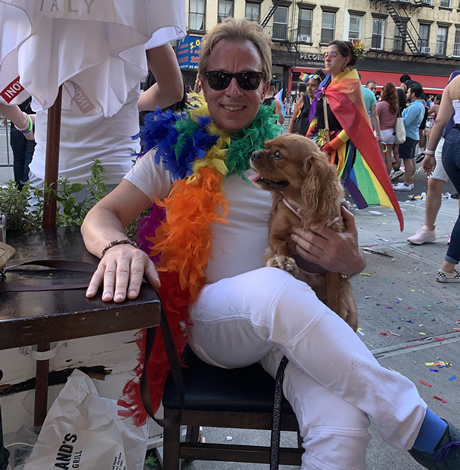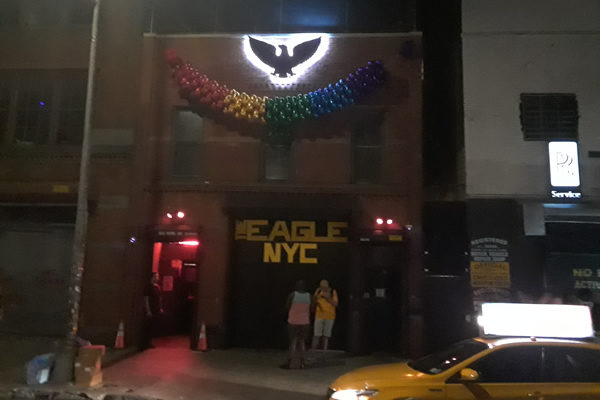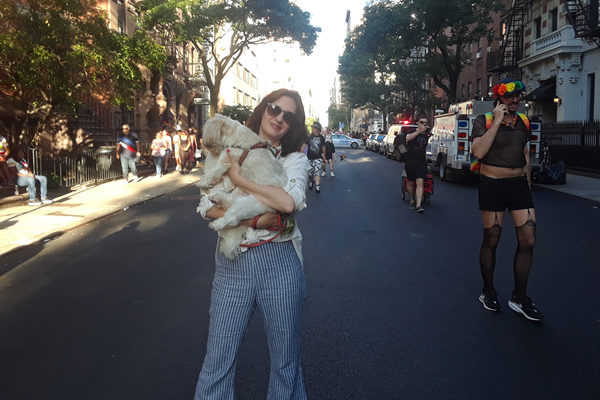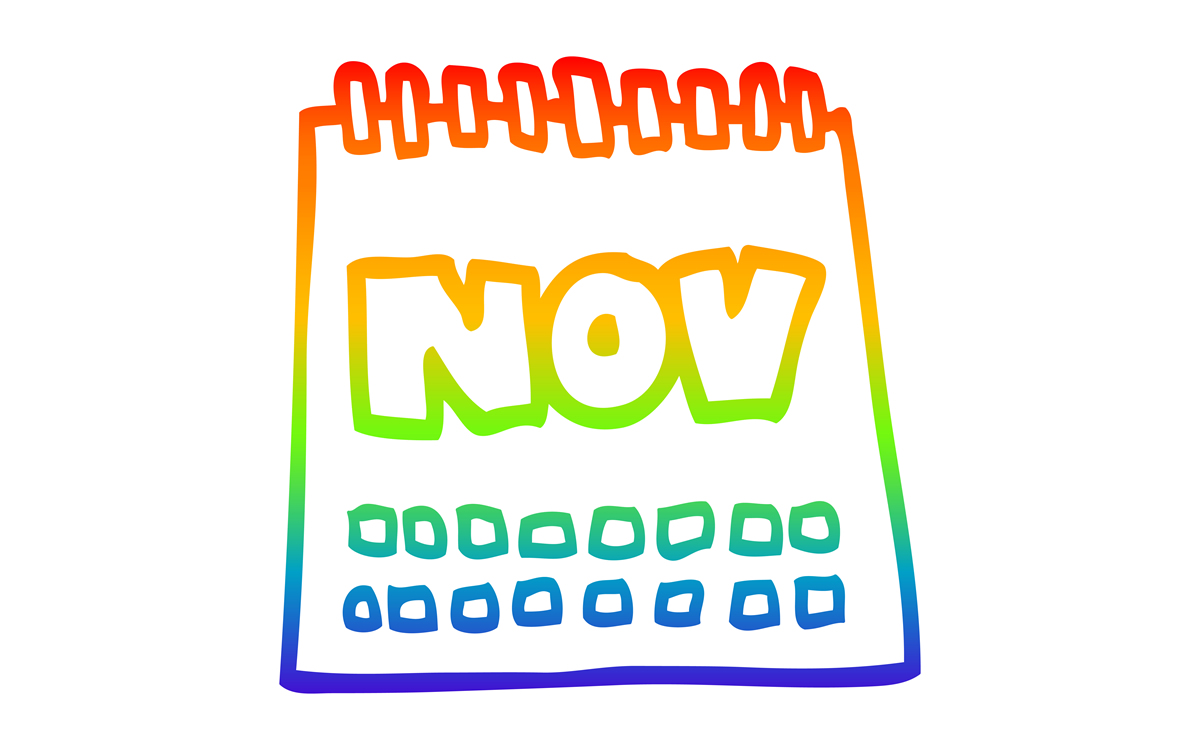Arts & Entertainment
Pride march brings gayborhood boom years back to Chelsea
‘We will continue what began 50 years ago, to bring us closer to equality’


From long lines to get into gay bars to crowded sex shop aisles to sidewalks dense with drag queens, daddies, dykes, twinks, tweakers, and wide-eyed tourists, Manhattan’s onetime ground zero of gayness had a déjà vu moment that lasted all day long, and well into the next, when Chelsea served as the end point of June 30’s NYC Pride March.
Cheered on by an estimated four million spectators, the March proceeded down Fifth Avenue from its East 26th Street kick-off, went past the Stonewall Inn during its Greenwich Village phase, then made its way up Seventh Avenue, concluding in the heart of Chelsea.
Twelve hours and 32 minutes after its noon start time, over 150,000 marchers had crossed the West 23rd Street finish line, from which point many remained in the area to congregate on stoops, hold impromptu dance-offs, and scoop up Stonewall 50 T-shirts hawked by vendors who turned side streets closed to vehicular traffic into open-air markets.
Some strolled, many strutted, down Eighth Avenue, between West 14th and 23rd Streets—which, at the height of Chelsea’s gay glory, housed dozens of queer-centric businesses, including gay lifestyle retail mecca Rainbows & Triangles, and The Big Cup—a java joint that served the community as, depending on your pop culture touchstone, the “Cheers” bar, Central Perk, Starbucks, or a brick and mortar Grindr, where hookup prospects were never more than 20 feet away.
By dawn, the streets were clean, and little evidence of the previous day’s record-setting revelry remained, save for the Pride-hued confetti that promises to linger, like Christmas tree needles, as a reminder of the season that came and went.
For longtime locals, the Pride March recalled an era when Chelsea was the reigning queen of NYC gay nightlife, retail, and residency.
“I consider the heyday of the Chelsea gay vibe to be when I moved here [in 1996] to until around 2005,” says 49-year-old Stephen Charles Lincoln, creator/proprietor of The Protein Bakery, a neighborhood fixture since 1999.
WorldPride, Lincoln notes, “was a fantastic reminder” of the heyday, “with the streets filled with gay people of every race, age, and sexual preference.”
While the onetime group fitness director at the predominantly gay David Barton Gym strongly disavows the notion that Chelsea is “over” as a gay neighborhood (“I’m still here,” he quips), Lincoln concedes it “has definitely diluted over the past 10 years.”
Unlike Splash, Rawhide, and View, not every gay bar from Chelsea’s golden age has been consigned to history.
Sixty-year-old Derek Danton, “an out business owner for 40 years, 20 with the Eagle NYC,” says there is “really nothing in my history to compare to the events of the last two weeks. Locals and visitors alike were just happy to be alive, happy to be free to express themselves, unconditionally.”
Located at West 28th Street and 11th Avenue since 2001, and one of the only Manhattan gay bars with a roof deck, the Eagle is set to mark its 50th anniversary next year.
“In its storied history,” Danton notes, “the size of the crowds at the Eagle, because of WorldPride, is unprecedented… It is astonishing to realize that so many thousands of visitors from all around the world know and love the Eagle, and that tradition is still valued.”

Andrew Rai, 38, a lifelong resident of Chelsea, talks of vanishing tradition, noting he feels the March “retains some of the rapidly fading cultural authenticity” of his neighborhood.
“Chelsea,” Rai says, “was very gay when I was growing up, was very vibrant, in terms of the variety of personalities, genders, and thoughts. Now, it’s becoming very homogenized. But this really harkened me back to when Chelsea was truly diverse. It makes me feel that there’s still some element of it, somewhere, that lives.”
Fifty-one-year-old Craig M. de Thomas, a partner in the Midtown-based commercial and residential title insurance company, Insignia National Title Agency, recalls “telling my grandmother I was gay when I was 25 years of age,” and often traveling “from upstate New York, to indulge in the gay life that is offered here. I have fond memories of going to the many Chelsea clubs, bars, and restaurants, truly enjoying life and always feeling safe and accepted. Seeing men openly sharing affection and being their authentic selves in public was incredible to me. I wanted to be part of that, which is why I moved here 11 years ago.”
Over the last few years, de Thomas observes, “We have seen Chelsea shift, as many gay business owners and residents have moved north [to Hell’s Kitchen].” This year’s Pride celebration, he says, “brought with it a much-needed injection of gayness to Chelsea. It was lovely to walk around over the weekend, both day and evening, and feel the gay energy again, to see restaurants, bars, and shops filled with life and happiness. It was a vibe that is reminiscent of days gone by.”
Calling the Pride March the “culmination of seeds sown decades ago, many of which were planted here in Chelsea by residents who still reside here,” de Thomas sees the neighborhood’s gay liberation greenhouse role as an ongoing one, noting, “We are the fruits” of those seeds and, as such, “will continue what began 50 years ago, to bring us closer to equality” while celebrating “the beauty and power of diversity.”
That Chelsea diversity has legs—four of them, in the form of many locals for whom Sunday’s Parade March intersected with the daily duties of dog ownership.
Chicago-to-NYC transplant Abbey Stolle spoke with the Blade while walking her Shih Tzu, Donna, in close proximity to their residence at 21st Street and Seventh Avenue, where one of the event’s green-shirted volunteers held a sign letting March participants know they were two blocks from the route’s end.
“People want to feel joy. They want to feel love,” she says, of the neighborhood’s sudden population explosion. “I’ve been out here all day. No one I know living here has ever complained [about the crowds brought by the March], and I have a mixed bag in my building—young, old, gay, straight, trans.”
Detroit-born Stolle, 37, spoke with this 52-year-old reporter about his having grown up during the height of the AIDS crisis, and put her own experience within the context of “my era, Matthew Shepard, that fear of coming out in the ’90s. I was a raver for 15 years. Gay men took me under their wing.”
As “a straight white woman,” Stolle notes, “I guess I feel a bit inferior on a day like today. This is a weighted year. These are people,” Stolle said, of the Stonewall-era faces in the March and on the streets, “who’ve lived through so much, who are still living here.”
Clarifying her use of that charged word, Stolle says she did not invoke inferiority “in a negative way. It’s just, it’s not my day. What are my woes compared to some of the strife these people are going through? But I’m a woman, so I get that taste, that sprinkle.”

Having watched the day’s events from a table outside Cafe Champignon (Seventh Avenue between West 21st and 22nd Streets), de Thomas recalls, “I stated to my darling friends, gay and straight, as we were sitting in the midst of millions of celebrants, ‘I absolutely love that this is our normal. Isn’t it fantastic?’ ”

Movies
Superb direction, performances create a ‘Day’ to remember
A rich cinematic tapestry with deep observations about art, life, friendship

According to writer/director Ira Sachs, “Peter Hujar’s Day” is “a film about what it is to be an artist among artists in a city where no one was making any money.” At least, that’s what Sachs – an Indie filmmaker who has been exploring his identities as both a gay and Jewish man onscreen since his 1997 debut effort, “The Delta” – told IndieWire, with tongue no doubt firmly planted in cheek, in an interview last year.
Certainly, money is a concern in his latest effort – which re-enacts a 1974 interview between photographer Peter Hujar (Ben Whishaw) and writer Linda Rosenkrantz (Rebecca Hall), as part of an intended book documenting artists over a single 24-hour period in their lives – and is much on the mind of its titular character as he dutifully (and with meticulous detail) recounts the events of his previous day during the course of the movie. To say it is the whole point, though, is clearly an overstatement. Indeed, hearing discussions today of prices from 1974 – when the notion of paying more than $7 for Chinese takeout in New York City seemed outrageous – might almost be described as little more than comic relief.
Adapted from a real-life interview with Hujar, which Rosenkrantz published as a stand-alone piece in 2021 (her intended book had been abandoned) after a transcript was discovered in the late photographer’s archives, “Peter Hujar’s Day” inevitably delivers insights on its subject – a deeply influential figure in New York culture of the seventies and eighties, who would go on to document the scourge of AIDS until he died from it himself, in 1987. There’s no plot, really, except for the recalled narrative itself, which involves an early meeting with a French journalist who is picking up Hujar’s images of model Lauren Hutton, an afternoon photo shoot with iconic queer “Beat Generation” poet/activist Allen Ginsburg, and an evening of mundane social interaction over the aforementioned Chinese food. Yet it’s through this formalized structure – the agreed-upon relation of a sequence of events, with the thoughts, observations, and reflections that come with them – that the true substance shines through.
In relaying his narrative, Hujar exhibits the kind of uncompromising – and slavishly precise – devotion to detail that also informed his work as a photographer; a mundane chronology of events reveals a universe of thought, perception, and philosophy of which most of us might be unaware while they were happening. Yet he and Rosenkrantz (at least in Sachs’ reconstruction of their conversation) are both artists who are keenly aware of such things; after all, it’s this glimpse of an “inner life” of which we are rarely cognizant in the moment that was/is their stock-in-trade. It’s the stuff we don’t think of while we’re living our lives – the associations, the judgments, the selective importance with which we assign each aspect of our experiences – that later becomes a window into our souls, if we take the opportunity to look through it. And while the revelations that come may occasionally paint them in a less-than-idealized light (especially Hujar, whose preoccupations with status, reputation, appearances, and yes, money, often emerge as he discusses the encounter with Ginsberg and his other interactions), they never feel like definitive interpretations of character; rather, they’re just fleeting moments among all the others, temporary reflections in the ever-ongoing evolution of a lifetime.
Needless to say, perhaps, “Peter Hujar’s Day” is not the kind of movie that will be a crowd-pleaser for everyone. Like Louis Malle’s equally acclaimed-and-notorious “My Dinner With Andre” from 1981, it’s essentially an action-free narrative comprised entirely of a conversation between two people; nothing really happens, per se, except for what we hear described in Hujar’s description of his day, and even that is more or less devoid of any real dramatic weight. But for those with the taste for such an intellectual exercise, it’s a rich and complex cinematic tapestry that rewards our patience with a trove of deep observations about art, life, and friendship – indeed, while its focus is ostensibly on Hujar’s “day,” the deep and intimate love between he and Rosenkrantz underscores everything that we see, arguably landing with a much deeper resonance than anything that is ever spoken out loud during the course of the film – and never permits our attention to flag for even a moment.
Shooting his movie in a deliberately self-referential style, Sachs weaves the cinematic process of recreating the interview into the recreation itself, bridging mediums and blurring lines of reality to create a filmed meditation that mirrors the inherent artifice of Rosenkrantz’s original concept, yet honors the material’s nearly slavish devotion to the mundane minutiae that makes up daily life, even for artists. This is especially true for both Hujar and Rosenkrantz, whose work hinges so directly to the experience of the moment – in photography, the entire end product is tied to the immediacy of a single, captured fragment of existence, and it is no less so for a writer attempting to create a portrait (of sorts) composed entirely of fleeting words and memories. Such intangibles can often feel remote or even superficial without further reflection, and the fact that Sachs is able to reveal a deeper world beyond that surface speaks volumes to his own abilities as an artist, which he deploys with a sure hand to turn a potentially stagnant 75 minutes of film into something hypnotic.
Of course, he could not accomplish that feat without his actors. Whishaw, who has proven his gifts and versatility in an array of film work including not only “art films” like this one but roles from the voice of Paddington Bear to “Q” in the Daniel Craig-led “James Bond” films, delivers a stunning performance, carrying at least 75% of the film’s dialogue with the same kind of casual, in-the-moment authenticity as one might expect at a dinner party with friends; and though Hall has less speaking to do, she makes up for it in sheer presence, lending a palpable sense of respect, love, and adoration to Rosenkrantz’s relationship with Hujar.
In fact, by the time the final credits role, it’s that relationship that arguably leaves the deepest impression on us; though these two people converse about the “hoi polloi” of New York, dropping legendary names and reminding us with every word of their importance in the interwoven cultural landscape of their era, it’s the tangible, intimate friendship they share that sticks with us, and ultimately feels more important than any of the rest of it. For all its trappings of artistic style, form, and retrospective cultural commentary, it’s this simple, deeply human element that seems to matter the most – and that’s why it all works, in the end. None of its insights or observations would land without that simple-but-crucial link to humanity.
Fortunately, its director and stars understand this perfectly, and that’s why “Peter Hujar’s Day” has an appeal that transcends its rarified portrait of time, place, and personality. It recognizes that it’s what can be read between the lines of our lives that matters, and that’s an insight that’s often lost in the whirlwind of our quotidian existence.
Out & About
Gala Hispanic Theatre’s Flamenco Festival returns

Gala Hispanic Theater will host the 21st Annual “Fuego Flamenco Festival” from Thursday, Nov. 6 to Saturday, Nov. 22.
The festival will feature American and international artists who will gather in the nation’s capital to celebrate the art of Flamenco. Guests can save 20% on tickets with a festival pass.
The festival kicks off now through Nov. 10 with the D.C. premiere of Crónica de un suceso, created, choreographed and performed by Rafael Ramírez from Spain, accompanied by renowned flamenco singers and musicians. In this new show, Ramírez pays homage to the iconic Spanish Flamenco artist Antonio Gades who paved the way for what Flamenco is today. GALA’s engagement is part of an eight-city tour of the U.S. by Ramírez and company.
The magic continues Nov. 14-16 with the re-staging of the masterpiece Enredo by Flamenco Aparicio Dance Company, a reflection of the dual nature of the human experience, individual and social, which premiered at GALA in 2023.
For more information, visit the theatre’s website.

Friday, November 7
“Center Aging Friday Tea Time” will be at 12 p.m. in person at the DC Center for the LGBT Community’s new location at 1827 Wiltberger St., N.W. To RSVP, visit the DC Center’s website or email [email protected].
Go Gay DC will host “LGBTQ+ Community Social” at 7 p.m. at Silver Diner Ballston. This event is ideal for making new friends, professional networking, idea-sharing, and community building. This event is free and more details are available on Eventbrite.
Saturday, November 8
Go Gay DC will host “LGBTQ+ Community Brunch” at 12 p.m. at Freddie’s Beach Bar & Restaurant. This fun weekly event brings the DMV area LGBTQ+ community, including allies, together for delicious food and conversation. Attendance is free and more details are available on Eventbrite.
Sunday Supper on Saturday will be at 2 p.m. at the DC Center for the LGBT Community. This event will be full of food, laughter and community. For more information, email [email protected].
Monday, November 10
“Center Aging: Monday Coffee Klatch” will be at 10 a.m. on Zoom. This is a social hour for older LGBTQ adults. Guests are encouraged to bring a beverage of choice. For more information, contact Adam ([email protected]).
“Soulfully Queer: LGBTQ+ Emotional Health and Spirituality Drop-In” will be at 3 p.m. at the DC Center for the LGBT Community. This group will meet weekly for eight weeks, providing a series of drop-in sessions designed to offer a safe, welcoming space for open and respectful conversation. Each session invites participants to explore themes of spirituality, identity, and belonging at their own pace, whether they attend regularly or drop in occasionally. For more details visit the DC Center’s website.
Genderqueer DC will be at 7 p.m. on Zoom. This is a support group for people who identify outside of the gender binary, whether you’re bigender, agender, genderfluid, or just know that you’re not 100% cis. For more details, visit genderqueerdc.org or Facebook.
Wednesday, November 12
Job Club will be at 6 p.m. on Zoom. This is a weekly job support program to help job entrants and seekers, including the long-term unemployed, improve self-confidence, motivation, resilience and productivity for effective job searches and networking — allowing participants to move away from being merely “applicants” toward being “candidates.” For more information, email [email protected] or visit thedccenter.org/careers.
“Gay Men Speed Dating” will be at 7 p.m. at Public Bar Live. This is a fresh alternative to speed dating and matchmaking in a relaxed environment. Tickets start at $37 and are available on Eventbrite.
Thursday, November 13
The DC Center’s Fresh Produce Program will be held all day at the DC Center for the LGBT Community. People will be informed on Wednesday at 5 p.m. if they are picked to receive a produce box. No proof of residency or income is required. For more information, email [email protected] or call 202-682-2245.
Virtual Yoga Class will be at 7 p.m. on Zoom. This is a free weekly class focusing on yoga, breathwork, and meditation. For more details, visit the DC Center for the LGBT Community’s website.
-

 District of Columbia2 days ago
District of Columbia2 days ago‘Sandwich guy’ not guilty in assault case
-

 Sports3 days ago
Sports3 days agoGay speedskater racing toward a more inclusive future in sports
-

 Celebrity News5 days ago
Celebrity News5 days agoJonathan Bailey is People’s first openly gay ‘Sexiest Man Alive’
-

 Michigan4 days ago
Michigan4 days agoFBI thwarts Halloween terror plot targeting Mich. LGBTQ bars

















